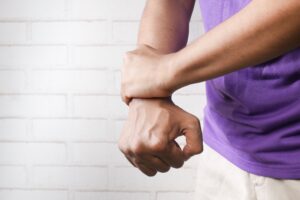
Your wrist is made up of eight small bones (carpal bones) plus two long bones in your forearm — the radius and the ulna. Your wrist functions as the link between the hand and the forearm. In your wrist, a tendon functions to move the bone. A ligament is a fibrous connective tissue that attaches bone to bone. There are no tendon attachments that function at the wrist. Tendons cross the wrist to insert into the hand, fingers, and thumb. And there are ligaments holding and stabilizing your wrist bones in place.
Problems affecting muscles that originate off the elbow and forearm may show up as pain at your wrist. Wrist conditions are often the result of trauma, overuse, and arthritis.
In athletes, positions that strain muscles repetitively are likely to cause an insidious (gradual) onset. Ultimately, this may lead to tendonitis. Tendonitis is inflammation or irritation of a tendon. Weight lifting, gymnastics, rowing, and racquetball are examples. Overuse with typing is a common problem. You may be a professional musician or be in assembly line movement patterns at work.
Below are conditions causing Wrist Pain: 5 Tendonitises a Chiropractor Can Help With.

De Quervain’s Tenosynovitis
You will have radial (thumb side) wrist pain. It may happen after forceful gripping activities with ulnar deviation (bending the wrist to the little finger) or repetitive use of the wrist or thumb.
Cause:
A synovial tendon sheath surrounds your wrist tendon. This is a lubricated layer of tissue in which the tendon is housed and through which it moves. And stenosing tenosynovitis is inflammation of a tendon and its synovial sheath. With de quervain’s tenosynovitis, two thumb muscles, the abductor pollicis longus (APL) and extensor pollicis brevis (EPB) tendons at your wrist become stenosed.
Intersection Syndrome
You will have pain and crepitus (“creaky” joints) 2 inches above the wrist on the dorsoradial (back side, above thumb) aspect. This is usually after repeated wrist flexion (bending palm down) and extension (raising back of hand) movements with occupational or sports activities.
Cause:
An inflammatory response and possible bursitis occurs at the crossing of two groups of tendons: the abductor pollicis longus (APL) and extensor pollicis brevis (EPB) tendons crossing over the top of the wrist. Bursae are fluid filled pads that act as cushions at the joints. Bursitis is inflammation of bursae. This occurs most often at joints that perform frequent repetitive motion. Intersection syndrome is more common in canoeists, weight lifters, and recreational tennis players.
Other Tendinopathies of the wrist:
Extensor pollicis longus (EPL)tendinitis/tendinosis
This muscle arises dorsolaterally (back or upper surface) from the middle part of the ulna (long forearm bone closest to fifth finger) and ends at the distal (tip) of the thumb. The EPL extends the thumb (moves the thumb away from the hand and parallel to the palm). This tendonitis is seen in drummers, athletes involved in racquet sports, and patients with rheumatoid arthritis.
Extensor indices proprius (EIP) syndrome and extensor digiti minimi (EDM) tendinitis/tendinosis
The Extensor indices proprius (EIP) is a narrow, elongated muscle in the deep layer of the dorsal (back of ) forearm. Its tendon goes to the index finger, which it extends (bends backward).
The extensor digiti minimi (EDM) is also a narrow muscle which originates in the lateral humerus (elbow area) and attaches to your 5th digit (5th finger). The EDM is a two joint muscle. It acts as an extensor in both joints. The EDM extends the wrist and the little finger. This means it moves the back of the hand toward the back of the forearm and straightens the little finger from a fist.
Extensor carpi ulnaris tendonitis/tendonosis
This muscle originates in the lateral humerus (elbow area). And it inserts into the 5th metacarpal (5th bone in palm of hand). The extensor carpi ulnaris serves to extend and adduct the hand (moving a hand toward the body) at the wrist. It is a relatively common tenonitis found in occupations or sports requiring repetitive wrist movement. Examples include racquet sports, rowing, golf, and baseball.

Chiropractic Treatment/Management of Wrist Tendonitises
In the acute phase, ice and rest from the causative activity are essential. Myofascial release techniques to the indicated muscles are effective. Chiropractic adjustments and mobilization to the wrist and associated areas give relief. Home-care advice includes icing, rest, wrist bracing, elevation and rehabilitation exercises. A positive outcome with a complete resolution of your wrist pain should be forthcoming.
Getting regular chiropractic care from a West Palm Beach wrist pain chiropractor can give relief naturally from an already existing injury, or even offer injury prevention. Chiropractic is a holistic and natural way to treat existing injuries and to keep your body in its best working condition.
Contact Meiri Chiropractic today at 561-253-8984 on Wrist Pain: 5 Tendonitises a Chiropractor Can Help With or/and other ailments.
References:
Thomas Bergman, David Peterson, Chiropractic Technique Principles and Procedures, 3rd edition, 2011